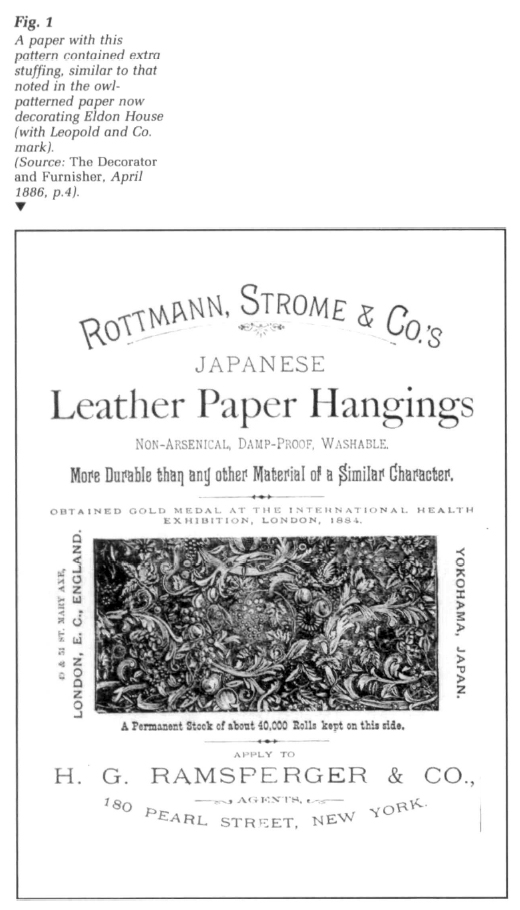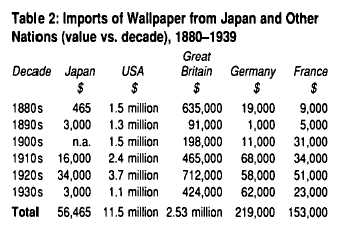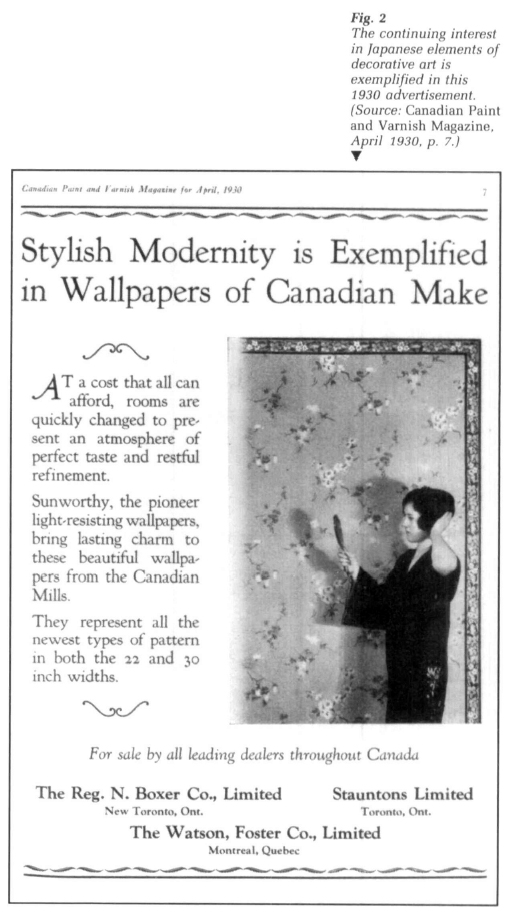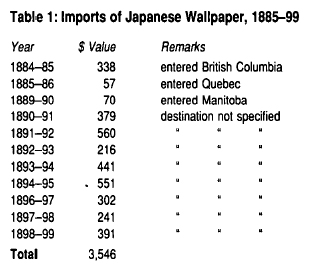Articles
Japanese Wallpaper in Canada, 1880s-1930s
This paper describes Japanese wallpaper exported to Canada (and other Western nations) beginning in the Meiji Restoration Period (1868-1912). The European fashion for embossed Renaissance leather hangings from the 1870s, the openness of Japan to Western trade and technology and the long-standing Japanese paper craft of making imitation leather led to the production of high quality handmade "leather" paper hangings for the Western market. Under the auspices of the Japanese government and the leadership of Alexander Rottmann of Great Britain, the first factory began operating at the Imperial Printing Works in Yokohama about 1883. Its goods and those of subsequent shops, together with grass cloths and other types of Japanese wall coverings, were exported in small but increasing amounts to Canada where they competed with Western manufactures. The costly imports inspired Canadian (and Western makers in general) to put out imitations, of which embossed grass cloths were the most popular during the early twentieth century. Like other Japanese commodities shipped via the Canadian Pacific Railway from the 1880s, wallpaper played its part in conveying elements of Japanese decorative art to Canadians.
Résumé
Cette étude porte sur les papiers peints japonais exportés au Canada (et dans d'autres pays occidentaux) depuis l'époque du Meiji (1868-1912). La vogue européenne des tentures Renaissance en cuir repoussé, à partir des années 1870, l'ouverture du Japon au commerce et à la technologie de l'Occident, et la technique japonaise traditionnelle du papier imitant le cuir ont donné lieu à la production de papiers peints simili-cuir de grande qualité fabriqués à la main pour le marché occidental. Sous les auspices du gouvernement japonais, la première fabrique, dirigée par Alexander Rottmann de Grande-Bretagne, s'établit à l'Imprimerie impériale de Yokohama vers 1883. Ses produits et ceux d'établissements postérieurs, de même que les toiles de ramie et d'autres genres de revêtements muraux japonais, furent exportés en petite quantité, mais en nombre croissant, vers le Canada où ils firent concurrence aux produits occidentaux. Le coût élevé des importations amena les fabricants canadiens (et occidentaux en général) à offrir des imitations, notamment des toiles de ramie gaufrées, articles très recherchés au début du XXe siècle. Comme d'autres produits japonais transportés par le Canadien Pacifique à partir des années 1880, le papier peint contribua à faire connaître aux Canadiens l'art décoratif japonais.
1 In the halls of Eldon House, London, Ontario, an embossed Japanese leather paper permits material historians a rare look at one of the highest quality wall coverings marketed in Canada during the last quarter of the nineteenth century. Purchased in Japan after 18921 by members of the Harris family, the richly decorated pattern in high relief displays owls perched on acanthus leaves in over ten colours; gold lacquered leaves and terra-cotta ground stand out among shades of green, pink and brown. Its swirly style, sometimes referred to as "Modern English" by British contemporaries, was inspired during the Aesthetic Movement (1860s-90s), a period of many influences including Japanese arts and crafts. The paper's selvage bears a gold embossed mark, "Leopold & Co London & Japan," a London trading firm specializing in Japanese goods at the end of the century. No pattern like it has been found in available sources.2
2 Little has been written about the wallpaper made in Japan during the last quarter of the nineteenth century. Present evidence suggests that its manufacture and export was the result of two influences in Great Britain during the Aesthetic Movement. The first was a revived interest in early embossed leather hangings at a time when papermaking technology using wood and a host of other materials enabled feasible imitations by wallpaper makers. The second was Japan's openness to Western trade and technology during the Meiji Restoration (1868-1912). The coincidence of the two brought the West into contact with the Japanese craft of making imitation leather. An article in the American Artisan in 1870 described a manufactory near Yeddo (Tokyo) where paper, previously produced near Nagasaki, was pressed into a variety of imitation leathers which were "washable without injury ... due to the [superior] mode manufacture."3 Used for many purposes, the "leather" cost eight to fourteen cents per sheet measuring 60 cm by 42 cm (24 1/2 inches by 16 1/2 inches).
3 British historians state that the embossing of leather wallpaper for the Western market began in the mid-1870s. This imitation may have been the same as made by craftsmen who were visited in 1877 by Dr. Christopher Dresser, noted British botanist, artist and author who toured Japan to collect samples of art-manufactures for Western makers.4 Some may have been exhibited at the 1878 Exposition universelle et internationale in Paris where Japanese exhibits in the wallpaper class won three awards. French historians list "Ikébé (K.)" as a winner of a bronze medal, and "Haïbara" and "Imaï" as recipients of honourable mentions,5 although the list gives no indication that prizes were for leather papers. As early as the 1860s imitation leather was exported to the United States. Referred to as "oil leather papers," they were more expensive than later varieties and used economically to panel cabinets and line furniture.6 Perhaps they were the same as the "stamped" leather papers made near Tokyo which Christopher Dresser wrote were the chief export variety prior to 1877.7
4 By the 1880s Japanese leather wallpapers displaying international designs were finding an assured market in the West. Historians credit Alexander Rottmann, "a man of fine artistic taste,"8 with its growth. He began by engaging Japanese artisans in small shops and ended by establishing a large enterprise under the auspices of the Japanese government. At the Imperial Printing Works in Yokohama, where bank notes, primers and state documents were printed, Rottmann gained the assistance of government officials in setting up a section for the manufacture of embossed leather hangings in styles and in a format (rolls) suited to the Western market. He organized the house of Rottmann, Strome and Co., Yokohama and London, in 1883 with exclusive rights to export leathers. Some displayed Japanese elements of design, others imitated Renaissance leathers. A number were designed by well-known British artists such as Arthur Silver and Harry Napper. As Western demand increased the government opened a Tokyo factory. About 1890 both operations were relinquished by the government and purchased by Rottmann, Strome and Kobayishi Beiki as the Yamaji Hekishi Shawan Paper Co.9
5 Rottmann's papers were "non-arsenical, damp-proof, washable . . . more durable than any other material of a similar character."10 In 1884 the company obtained a gold medal at the London International Health Exhibition and in 1885 a silver medal at the Antwerp Exhibition.11 The firm's 1886 statement that it was the "original manufacturer of the highly embossed Japanese Wall Hangings which require no after treatment"12 implied competition with British sanitary papers which were colourable after purchase, such as Lincrusta Walton and Anaglypta. Improvements to the Japanese process13 may have included the option of ground colour. A description of how "world famous leathers" were made at the Imperial Works in Yokohama in 1896 stated that goods were rarely shipped before grounding:
6 The Eldon House leather fits the above description. In addition, the highly embossed owl pattern contains extra stuffing in some areas, a detail recorded in an 1885 account of operations at the Imperial Works.15 Similar stuffing was noted by Richard Nylander in an embossed fruit and foliage pattern advertised by the Rottmann firm beginning in 1884 (see fig. 1).16
7 Like most Japanese leathers the Eldon House paper was adaptable as a dado or filler. Measuring 37 inches wide (or 35 3/4 inches of pattern after removing two selvages), its width and the orientation of the pattern made it appropriate for hanging either horizontally as a dado or over the entire wall. The Harris family chose to hang it vertically from floor-board to cornice in the upper front hall and as a filler from chair rail to cornice in the lower back hall. Durable and solid after installation, Japanese leathers were advertised for halls and staircases. Washability made them suitable for dining rooms but they were appropriately hung on any important room in houses, theatres and public buildings. They were used on ceilings as well as walls.
 Display large image of Figure 1
Display large image of Figure 18 How long the Rottmann factories in Japan and London were the exclusive source17 of Japanese leathers in the West is uncertain. Leopold and Co. was apparently exporting in the 1890s, and the W.H.S. Lloyd Co. specialized in Japanese wallpaper as late as the First World War.18 Moreover numerous Japanese factories existed, judging from the more than a dozen prizes won in 1889, 1900 and 1925 for wallpaper at Paris exhibitions alone.19 Tokyo, Gifu and the prefecture of Mie were locations given for three winning shops in 1900. The prize winners listed below (in romanized French) represent just a few of the Japanese firms exhibiting various types of wallpaper at Paris exhibitions from 1878 to 1925.20
Horiki (Tchùtaro) à Miyé-kén in 1900
Oseki (Jishichi) in 1925
Suzuki (Toramatsu) in 1925
Horiki (Chiutaro) in 1889
Yamada (Jirobei) in 1889
Iro (Sôjiro) à Tokio in 1900
Také-I (Sukéyémon) à Guifu in 1900
Daisei-Shokai in 1925
Murase (Eikichi) in 1925
Ikébé (K.) in 1878
Kinsenhatsu Tsushi Kaisha in 1925
Haïbara in 1878
Imaï in 1878
Teshigawara Goshi Kaisha in 1925
9 Research of Japanese sources needs to be done to determine the wallpaper made at the above shops. Available evidence indicates that a variety of wallpaper was exported to North America from the 1880s. In addition to the leathers previously described, there were grass cloths, grass papers, tea-box papers and small sheets. This account was written during a period of popularity in 1918:
With the exception of the tea-box papers and the small sheets of paper, the grass cloths, grass papers and leathers were well-documented in Canada.
10 The first mention of Japanese wallpaper in Canada noted by the author was in 1880 and referred to leather goods. An article titled "Paper Hangings" under the column "Ladies Department" in Toronto's The Weekly Globe reported:
These were among the most expensive grades of wallpaper on the market and were shipped to Canada via Great Britain and the United States.
11 The first importer noted was M. Staunton and Co., Canada's major wallpaper manufacturer at the time. In March 1884 the Toronto company advertised "Japanese leather and lacquered gold papers," which it retailed with Canadian goods and other imported specialties. Like Haïbara and Imaï of Japan, the Staunton firm had been awarded an honourable mention for wallpaper at the 1878 Paris exhibition.23 Exposure to Japanese decorative art then (indeed as early as the 1867 Paris exposition) may have led the firm to import Japanese papers before 1884.
12 Large decorating houses advertised embossed leather. In 1885 "Japanese Leather Paper in High and Low Relief, From Yokohama, Japan," was advertised by Castle and Son, a Montréal decorator and stained-glass manufacturer. The goods may have been those of Rottmann, Strome and Co. Also in Montréal DeZouche and Sons in 1886 reported "gold embracing English tapestry papers and Japanese designs." In 1891 the firm carried "a line of English, French and American paperhangings and decorations.... in all newest styles, including English tapestry and Japanese designs in rich, elegant, bright shades and tints and combinations of colours." In 1894 Japanese designs were in its large inventory.24
13 In 1888, Toronto decorator Elliott and Son advertised Japanese leathers with other high quality goods in Saturday Night:
The same magazine in 1893 reported Elliott and Son as having "Wall Hangings — silks, cretonnes, relief materials such as Japanese leather, Lincrusta, Anaglypta and wallpapers from $.10 to $10.00 per roll."26
14 The Canadian Architect and Builder noted in 1888: "Contracts — of Japanese raised leather paper designs for fillup, dadoes, borders and friezes, there is this spring an endless variety."27 A decade later the view was expressed that:
Nevertheless, the popularity of Japanese leather continued into the twentieth century. From 1900 until 1908 they were the highest priced wallpaper advertised in catalogues of the T. Eaton Co.
15 Eaton's 1900 spring and summer catalogue announced that "the latest American, English, Canadian and Japanese Wall Papers are represented in our stock." This included: "The latest Japanese burlaps, wall papers and pebbled effects, and wall decorations. .50 - $1.50 yd."29 The pebbled effect described the type of embossing. The burlap may have referred to a woven textile, perhaps similar to Japanese mattings or what later was called grass cloth. Until 1908 Eaton's advertised "the newest Japanese leather Wall Papers for walls, dados" at prices ranging from $0.50 to $1.50 per yard.30
16 A variety of Japanese wallpaper is mentioned in The Canadian Bookseller and Stationer from 1910 to 1921: grass cloth, leathers (costing $18 a roll in 1920), Tekko (resembling glossy silk, sometimes embellished with gold, silver and metallic effects), foliage designs, and papers patterned with Japanese landscapes and lanterns.31 Grass cloths were the most popular and sold by the square yard or roll of eight yards. Natural grass cloth was admired for its coolness and utility as a background for pictures. Plain colours in tan, gray, golden brown, yellow, soft dull reds, blues and green retailed for $0.85 per square yard. Woven papers with metallic effects were slightly more expensive; they were advised for libraries, dining rooms and living rooms, where they harmonized with dark woodwork.32 Even more costly were patterned grass cloths, some stencilled with high art designs by the noted British firm of Shand Kydd Ltd.33
17 Official import records corroborate the existence of a variety of Japanese wallpaper in Canada. These begin to tally Japanese imports in the year 1884-85, coinciding with the construction of the Canadian Pacific Railway to Vancouver, despite the fact that some reached eastern Canada prior to this via the United States and Europe. Federal tables of trade and navigation first list $338 worth of goods entering British Columbia directly from Japan. Lesser values were slated later for Quebec and Manitoba. Increasing imports in the 1890s amounted to seven times the value of the 1880s (see tables 1 and 2).34
 Display large image of Table 2
Display large image of Table 218 The variety of wallpaper being imported is intimated by the classification system of various Customs Acts. In 1884-85 all wallpaper imports were classed under a single heading, "hangings or wall paper, and glazed, plated, marbled, enamelled or embossed paper, in rolls or sheets and cardboard similarly finished."35 Glazed, plated, embossed and enamelled describe Japanese leathers, although not exclusively. A second class of goods inserted in the act the following year to describe the great majority of imports did not apply to Japanese goods: "hangings or wall paper, in rolls, costing eight cents or under for rolls of eight yards in length and 18 inches wide."36
19 A better view is gained from analysis of the 1888-89 act which specified tariffs for eight classes of wallpaper. Japanese imports entered under four of the higher grades described as "white papers, grounded papers and satins, not hand made," "single print bronzes and coloured bronzes," "embossed bronzes," and a general category "hangings or wall paper, all other."37 Evidently more types than leather were being shipped: unembossed paper with and without bronze highlights as well as whites and satins. Under the general tariff of 1897, however, only two classes of goods, "hangings or wall paper" and "borders and bordering," were designated; all Japanese wall-paper came under the first. The following table indicates the value of each class of Japanese paper entering Canada from 1884 to 1899, with the years imported in parentheses:38
Hangings or wallpaper (1897-99) 632
White grounded satins etc. (1894-95) 462
Single print and colour bronzes (1893-95) 419
Hangings or wallpaper, etc. (1884-86) 395
Embossed bronzes (1889-94) 94
Total value of imports 3,546
20 In the twentieth century Japanese imports increased in value. A significant rise was noted during the decade of the First World War which can be attributed to the wartime decrease and/or the cessation of shipments from Great Britain, the United States, Germany and France. In the 1920s the largest value of wallpaper ever imported from Japan (to 1939) entered Canada. Despite the increase, however, the value was small compared with that from leading trading nations (see table 2 for a comparison by decade).39
21 To summarize, wall coverings known as leather, relief, sanitary and pressed papers were among the highest grades of wallpaper manufactured in Great Britain, Continental Europe, the United States and Japan from the last quarter of the nineteenth century. Made in varying thicknesses by a variety of patented methods, their diversity was equalled by the number of trade names they were given. Tynecastle Tapestry, Lincrusta Walton, Anaglypta, Cordelova, Salamander, Cameoid, Leatherette were a few made in Great Britain from the late 1870s. Japanese leathers, in contrast to those manufactured in the West, were handmade specialties (at least at first) which gained a reputation for their rich colour and high style.
22 The variety and value of Japanese wallpaper on the Canadian market was small (but not the smallest) in comparison with goods of other trading nations and the value per roll was high. Nevertheless, its influence was significant. The exotic rarities ranged from ornate leathers to plain grass cloths, and they created a demand for less expensive imitations which Western manufacturers competitively produced by machine. Like others, Canadian makers embossed grass-cloth effects, and such papers became best sellers during the first two decades of the twentieth century. Other imitations (less easy to attribute to Japan because they also had European precedents) were leatherettes and silks.
 Display large image of Figure 2
Display large image of Figure 223 The decorative art of Japan was an endless source of inspiration for wallpaper designers long after the end of the Aesthetic Movement. Translated from textiles, furniture, ceramics, wallpaper and other artifacts made in both Japan and the West, Japanese styles were featured regularly on wallpaper after 1900. Although motifs from every nation were also part of designers' repertoire, the Japanese styles were prevalent enough to be mentioned and displayed in advertisements. In 1927, Stauntons Limited in Toronto reported:
24 The evidence suggests that Western demand for leathers sparked the beginning of a wallpaper industry in Japan. The gold lacquered embossed paper in Eldon House is a rare reminder of the Meiji Era when international co-operation fostered one of several industries and brought Japanese artistry to the walls of the Western world in unprecedented amounts.
The author is grateful to Brigitte Laforce of London Historical Museums, Martin Weaver of Heritage Canada, and Caroline Jonas of Steptoe and Wife Antiques, Toronto, for information about the owl-patterned leather paper in Eldon House. The article is based largely on data compiled for the author's omnibus study, Wallpaper in Canada: 1600s-1930s, Microfiche Report Series no. 208 (Ottawa: Parks Canada, 1983).
